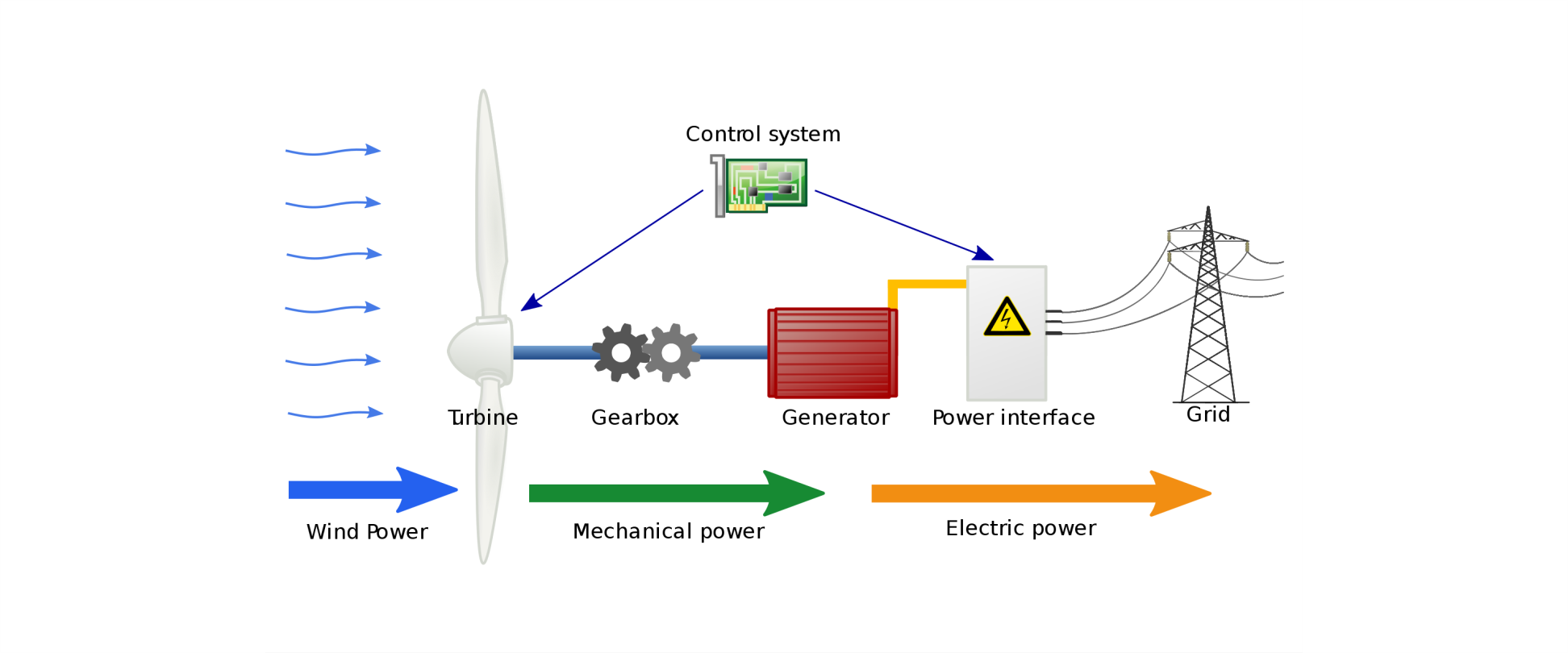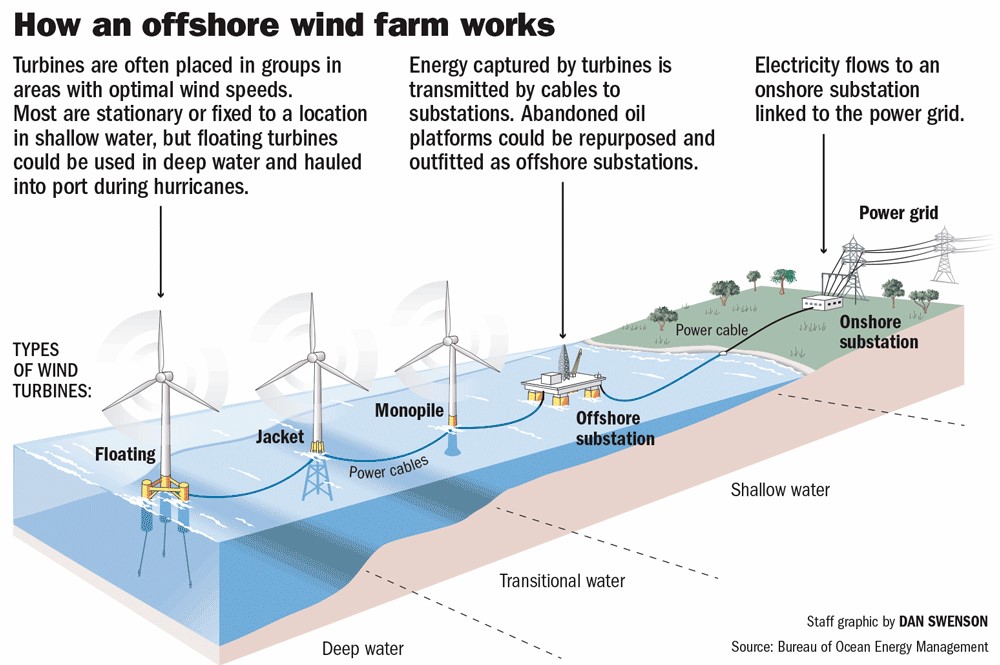Wind energy is one of the most widely used efficient and clean renewable energy source. Wind energy is obtained from wind power, the conversion of the kinetic energy of air currents into electrical energy. A wind turbine is used to use this kinetic energy and convert it into electricity.
Wind energy technologies
Wind turbines have different capacities depending on their height and rotor diameter. For optimal use of wind energy, wind power plants (WPPs) are being built in windy areas consisting of a large number of turbines which will produce a large amount of electricity.
Over the years, with the development of technology, the parameters of wind turbines have also changed.
 Source: http://data.bloomberglp.com/bnef/sites/14/2017/09/BNEF-Summit-London-2017-Michael-Liebreich-State-of-the-Industry.pdf
Source: http://data.bloomberglp.com/bnef/sites/14/2017/09/BNEF-Summit-London-2017-Michael-Liebreich-State-of-the-Industry.pdf
Wind turbines are divided into horizontal-axis wind turbines (HAWTs) and vertical-axis wind turbines (VAWTs). Currently, industrial-scale wind turbines used to create power plants or wind farms with the capacity to power grids are horizontal-axis wind turbines. Vertical-axis wind turbines are installed mainly in smaller areas where the rotor shaft is installed vertically and can generate electricity regardless of the wind direction.
Wind turbines mainly consist of three blades (wings) directed in the direction of the wind, the movement of these blades activate the three main parts of the wind turbine:
Rotor: Converts the kinetic energy of air currents into mechanical rotational energy. Consists of blades and their connecting parts.
Gear box: connected to the engine via a shaft and can increase the speed from 30 revolutions per minute (rpm) to 1500 revolutions.
Generator: converts the obtained mechanical energy into electrical energy.
.png)
Source: https://www.mdpi.com/2076-3417/9/12/2469/htm
Electricity generated by wind turbines is transmitted via transmission lines to the transformer substation and in the end to consumers through distribution networks.

Source: https://www.graphitestore.com/wind-turbine-power-brushes
In wind turbines, the electronic control system (recording information about many parameters of the turbine - wind speed, direction, generator and power generation) sends information to the system. Most modern turbines have a control system and a microprocessor for efficiency analysis. This control system also acts as a brake to prevent the turbine from malfunctioning at critical times (such as when the generator overheats and disconnects from the grid, in adverse weather conditions).
Wind Power Plants
WPPs are built after a rigorous analysis and planning process. The design of the wind farm complex is developed taking into account the environmental and social impacts, analyzing the spatial, time and variations of wind with the most modern calculation methods in the context of maximizing energy production. Depending on the location of wind turbines, WPPs are divided into onshore wind and offshore wind energy:
Onshore wind energy means electricity generated by onshore wind power plants. In 2020, the installed capacity of onshore wind power plants in the world was 698.9 GW.
China (273 GW), the United States (117.7 GW), Germany (54.4 GW), India (38.5 GW) and Spain (27 GW) are the top five countries with the largest capacity of wind power.
According to the Global Wind Report 2021, a total of 86.9 GW of onshore power plants that were installed worldwide in 2020 which is 59% more than in 2019. China and the United States, the two leading markets in this area, accounted for 75% of new installed capacity in 2020.
Offshore wind energy means the production of energy using wind currents from the seas and oceans at higher and more stable speeds due to the absence of additional barriers compared to onshore wind power plants. Megastructures are equipped with the newest technical innovations for using maximum capacity of offshore wind power. Offshore wind turbines can be in various forms, depending on the depth of the water, geotechnical features and environmental conditions. Fixed foundation wind turbines are considered optimal for water depths of less than 30 m, while floating wind turbines are considered optimal for depths of 50 m and more.

Source: https://www.boem.gov/
According to "Future of Wind - Future of Wind Energy" report published by the International Renewable Energy Agency (IRENA), global wind power could meet about 35% of electricity demand by 2050. The report says that the global offshore wind energy market grew by about 30% annually between 2010 and 2018. The European Union's (EU) offshore wind power capacity is currently 24 GW and is projected to reach about 130 GW in 2040.
The report of the International Renewable Energy Agency (IRENA) states that in 2019, the installed capacity for offshore wind energy reached 28.4 GW, and in 2020 - 34.4 GW. According to the Global Offshore Wind 2021 report, in 2020, offshore wind installed capacity was 6.1 GW. Offshore wind installed capacity in 2020 was 5% of total wind installed capacity.
Currently, there are 162 offshore wind farms in the world. Only in 2020, the construction of 26 offshore wind projects have begun. The United Kingdom (10 GW), China (8 GW), Germany (7 GW), the Netherlands (2.5 GW) and Belgium (2 GW) are the top five countries in the world with the installed capacity offshore wind power.
According to the International Renewable Energy Agency (IRENA), the installed capacity of wind power plants in the world was 733 GW in 2020. In 2020, the capacity of newly operated wind power plants in the world was 111 GW, as well as the world's largest renewable energy markets like China and US have built, offshore wind power plants with a capacity of 72 GW and 14 GW respectively.
In recent years, the development of technology, competitive supply chains and the gained experience have led to a downward trend in wind energy production costs. According to IRENA reports, between 2010 and 2019, there was a 39% decrease in onshore wind energy production costs and a 29% decrease in offshore wind energy production costs. Between 2019 and 2020, the Levelized Cost of Energy (LCOE) decreased by 13% and 9%, respectively.




